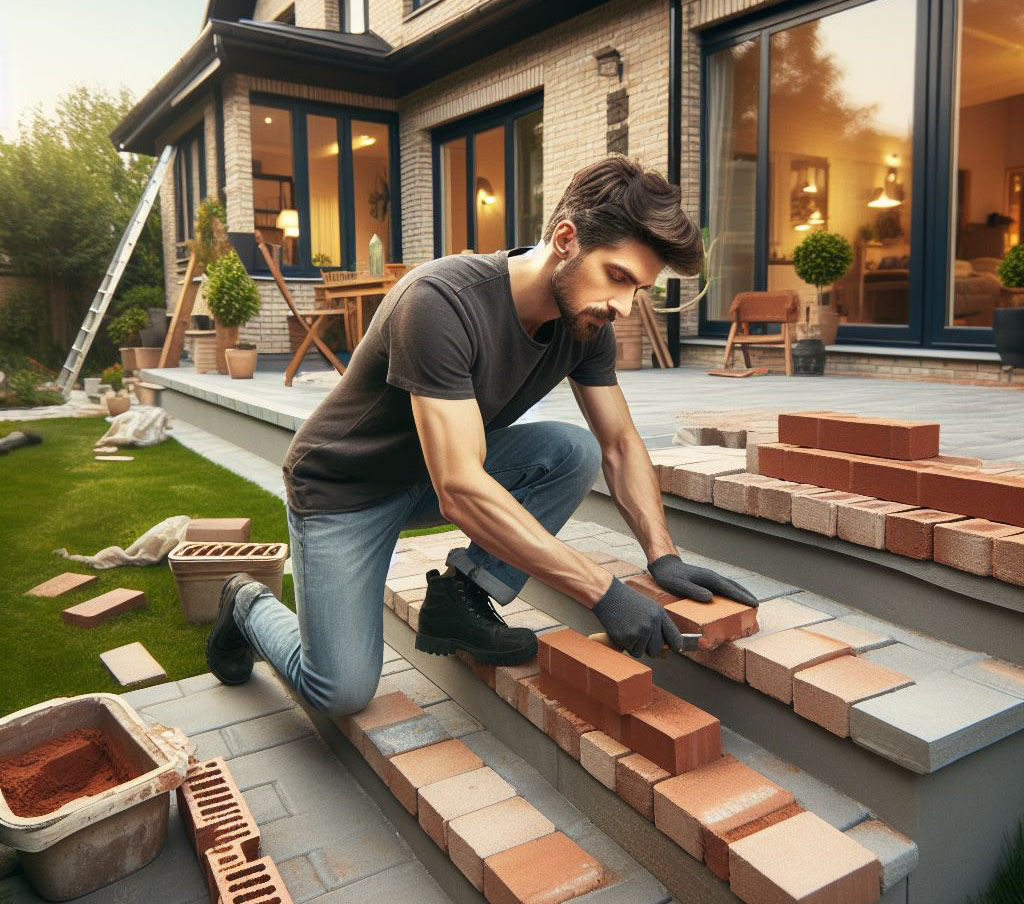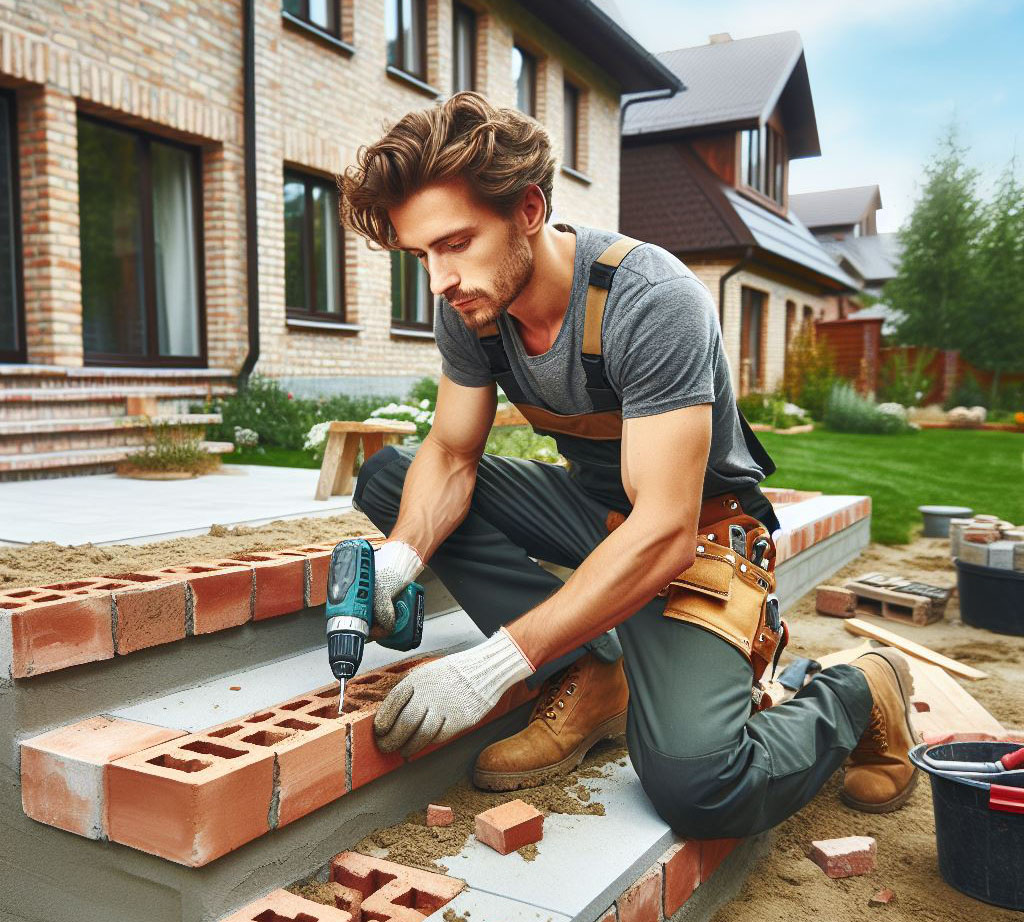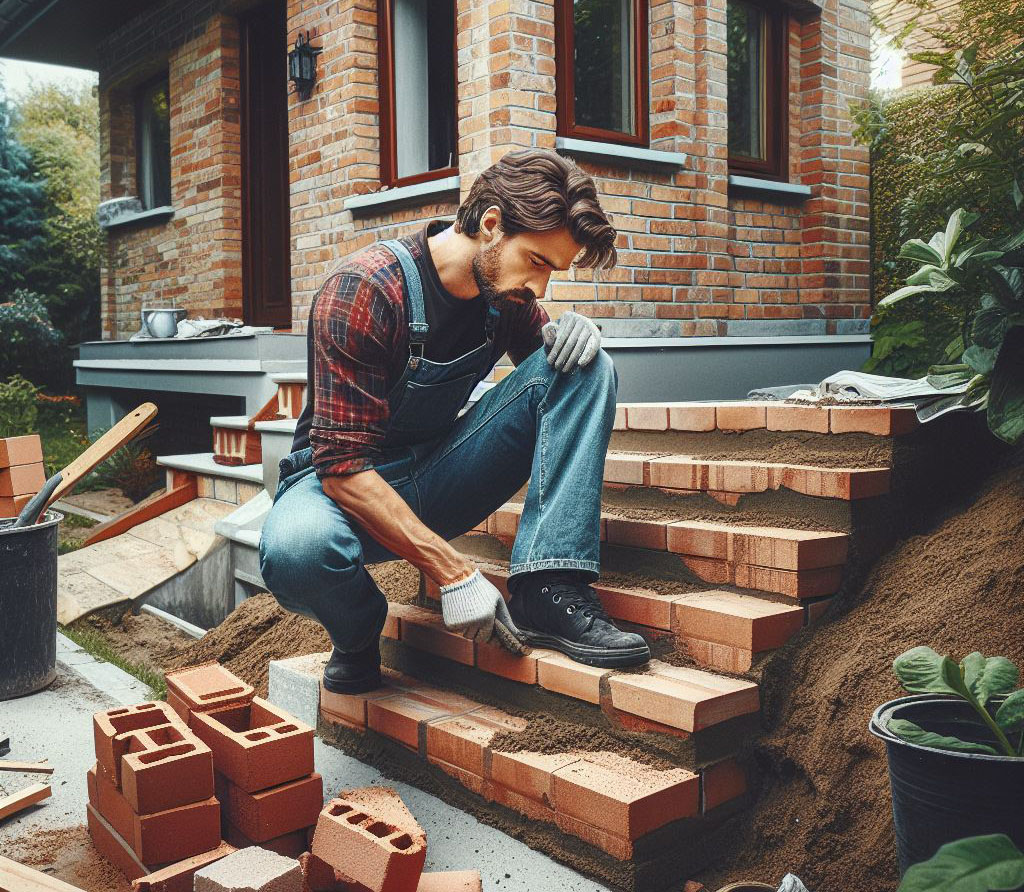In the realm of home improvement, brick steps stand as a testament to both the charm and challenges of maintaining a piece of timeless craftsmanship. These structures, while robust, require careful attention to preserve their structural integrity and aesthetic value. This guide is crafted for the ambitious home handyman and the diligent, self-employed construction professional, aiming to navigate the intricacies of brick step repair with precision and care.
Embracing the DIY ethos of brick step repair isn’t merely a cost-saving measure, it’s an investment in the life and longevity of your property. It’s about embracing the craftsmanship inherent in every brick and mortar joint and the satisfaction that comes from restoring beauty and safety to your home with your own hands.

Understanding Brick Steps
Brick, with its rich history in construction, is celebrated for its strength, adaptability, and timeless beauty. However, exposure to the elements and the passage of time can bring to light vulnerabilities such as weathering, which erodes the brick’s surface, loosening of bricks, posing a risk to stability, and cracking, threatening the structural soundness.
Yet, the enduring nature of brick steps, their distinctive character, and the relative ease of repair, make them a preferred choice for many. With the right maintenance, these steps can serve as a durable and attractive pathway for countless footsteps.
Assessing the Damage
A meticulous examination is the cornerstone of any successful repair. Here’s a detailed roadmap to evaluating the condition of your brick steps:
- Visual Inspection: Conduct a thorough survey, noting any apparent damage such as dislodged or absent bricks, visible cracks, or an uneven surface.
- The Tap Test: A gentle tap on the bricks with a handle can reveal hidden flaws. A hollow sound might indicate voids underneath the bricks, a precursor to more significant issues.
- Mortar Check: Scrutinize the mortar joints. If they show signs of deterioration, such as easy crumbling or visible gaps, it’s a clear call to action.
- Stability Test: Gently apply pressure to the bricks to check for any movement. A stable brick shouldn’t budge, and if it does, it’s a signal for potential re-setting or at least, re-pointing of the mortar.

Materials and Tools Required
Precision in brick step repair is not just about technique, it’s equally about the quality of the materials and the reliability of your tools. Here’s a curated list of essentials for a robust repair:
Materials
- Replacement Bricks: Opt for bricks that closely resemble the existing ones to maintain uniformity in your repair.
- Mortar: Choose a type that aligns with the original material. Typically, Type N mortar is a versatile choice for above-ground projects.
- Sand: A crucial component if you’re mixing your mortar from scratch, lending the right consistency and strength.
Tools
- Chisel and Hammer: Your primary tools for removing old, stubborn mortar with precision.
- Trowel: An indispensable tool for applying new mortar and setting the bricks with accuracy.
- Masonry Brush: Essential for clearing out debris and ensuring a clean workspace for the new materials.
- Pointing Tool: The key to achieving a professional finish on your mortar joints.
Pro Tips
- Mortar Matching: Ensure that the new mortar mirrors the old in color and texture for a seamless repair.
- Invest in Quality: Opting for high-grade materials pays dividends in the longevity and appearance of your repair.
- Tool Maintenance: A well-maintained set of tools is critical for precision and ease in your repair work.
Preparation for Repair
Embarking on the repair journey requires a methodical approach to setting up your workspace. Meticulous preparation not only facilitates a smoother workflow but also ensures the longevity of your repair.
- Clear the Area: Start with a clean slate. Removing any detritus, like leaves or loose gravel, will provide you with a clear, safe area to work in, reducing the risk of accidents.
- Remove Loose Debris: Employ a stiff brush to meticulously clear away any flaking mortar or brick fragments. This step is crucial for ensuring the new material adheres properly and provides a solid, enduring repair.
- Safety First: Never underestimate the importance of proper gear. Protective gloves, safety glasses, and durable boots are non-negotiable to safeguard against potential hazards. Knee pads are also highly recommended to protect your joints during prolonged periods of kneeling.

The Repair Process
Approach each phase of the repair process with diligence and care. Every step, from removing damaged bricks to applying the finishing touches, is an opportunity to enhance the structure’s integrity and appearance.
Removing Damaged Bricks
- Chisel Out the Old Mortar: A cold chisel and club hammer will be your primary tools here. Employ a gentle, yet firm, approach to remove the mortar without damaging the surrounding bricks.
- Lift Out the Brick: Some bricks may yield easily, while others might require a more delicate touch with a brick bolster. Patience is key, avoid rushing this step to prevent unnecessary damage.
Preparing the New Bricks and Mortar
- Mortar Mix: Adhere to the 3:1 sand-to-cement ratio for a balanced mix. Achieve a consistency akin to peanut butter for optimal application. The right consistency ensures the mortar adheres properly and dries with adequate strength.
- Soak Your Bricks: Briefly immerse the bricks in water to prevent them from absorbing moisture from the mortar too rapidly. This step is essential for ensuring a strong bond and preventing premature drying.
Laying and Securing New Bricks
- Butter the Brick: Generously apply mortar to the contact sides of the brick, much like spreading butter on bread. This ensures full coverage and a secure fit.
- Lay the Brick: Position the brick with firm, deliberate pressure. A slight wiggle ensures it’s properly seated in the mortar, ensuring stability and alignment.
Pointing and Finishing Touches
- Fill the Joints: Use a pointing tool or the back of a trowel to pack the mortar into any voids, smoothing it for a polished finish.
- Clean as You Go: Maintain a clean finish by wiping away excess mortar with a wet sponge. Precision in this step greatly influences the overall aesthetic of your repair.
Aftercare and Maintenance
The longevity of your repair is significantly influenced by the care and maintenance that follows. Regular attention will safeguard your work against the elements and time.
- Keep ’em Clean: Regular cleaning prevents the accumulation of substances that can lead to deterioration. A simple routine can significantly extend the life of your brick steps.
- Regular Inspections: Periodic examinations allow for early detection of potential issues, simplifying future repairs and preventing minor problems from escalating.
FAQ Section
Biannual inspections, typically in the spring and fall, are advisable to catch and address any emerging issues promptly.
Type N mortar is generally recommended for its balance of flexibility and strength, making it suitable for above-ground applications.
While initial setting occurs within the first 24 hours, a full cure usually requires around 28 days. It’s crucial to avoid heavy traffic on the steps during the initial setting period.
For optimal aesthetic and property value, closely matching the existing bricks is preferred. However, if the repair is in a less visible area, a mismatched brick can serve as a practical, temporary solution.
Hastening the process, inadequate preparation, and incorrect mortar mixing are frequent pitfalls. Dedication to each step of the process ensures a repair that is both durable and visually appealing.
